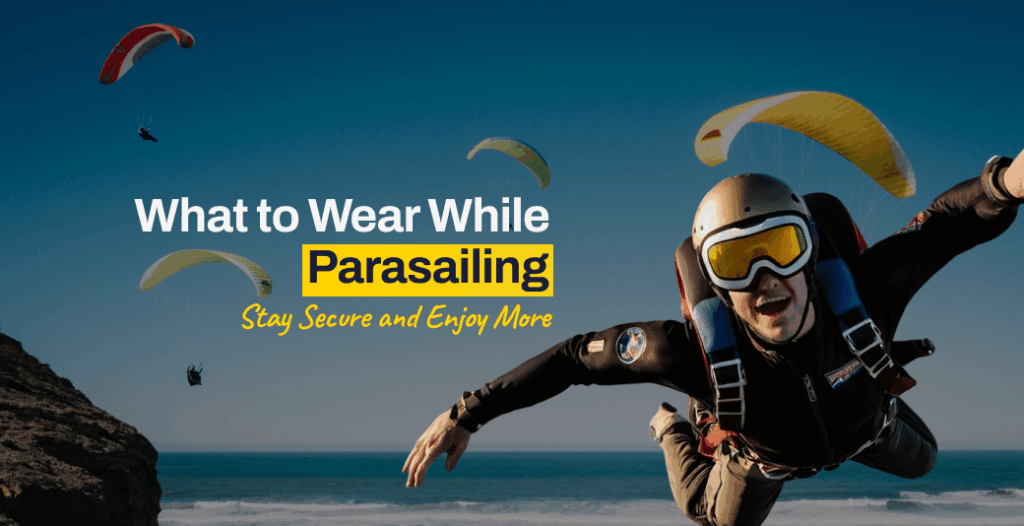Parasailing Places I’ve Loved and What to Wear
Before I go parasailing, I always choose clothes that keep me safe and comfortable. I have parasailed in some amazing places. Bali’s warm ocean breeze made the ride smooth and fun. In the Maldives, the clear blue water stretched as far as I could see.
I also flew high above the Gold Coast in Australia, where the wind bites just right. New Zealand’s lakes gave me a fresh chill and stunning views. And in Thailand, the tropical air made every second feel alive.
When you plan your trip, knowing what to wear while parasailing is key. Each place has its own weather and wind. Dress for comfort, sun, and safety. This simple step helped me enjoy every flight without worry. Here’s exactly what works best, and what doesn’t, when getting dressed for the sky.
1. Swimwear That Won’t Fail Mid-Air
Why It Matters
Parasailing means you might get wet from waves, spray, or even a splash landing. Wearing the right swimwear keeps you comfortable and quick to dry. Loose or heavy clothes soak up water and slow you down.
True Story
In Bali, I wore a one-piece under a rash guard. My friend wore a strappy bikini, which flew up during takeoff. She spent most of the ride trying to keep it in place instead of enjoying the view.
Best Options
- One-piece swimsuits or snug bikinis fit tight and stay put.
- Quick-dry boardshorts or swim trunks work great for men and women.
Avoid This
- Baggy clothes that flap in the wind.
- Jeans or cotton, which get heavy when wet and take forever to dry.
2. Secure Your Footwear
Best Footwear
Most parasailing spots suggest going barefoot for the best grip and safety. But if shoes are allowed, pick water shoes or snug sandals with straps.
True Story
In the Maldives, I watched someone lose a brand-new slide sandal just as the parachute lifted off. It splashed into the ocean and vanished.
Avoid This
- Flip-flops or loose sandals that can slip off mid-air.
- Heavy shoes that weigh you down or cause discomfort.
3. Add Lightweight Layers (If Needed)
When to Add a Layer
Early mornings, windy days, or cooler seasons call for extra protection. The wind up high can chill you even if the sun is out.
What to Wear
- UV-protective rash guards or quick-dry long-sleeve shirts guard your skin and keep you warm.
- Light windbreakers block wind without bulk.
True Story
In Gold Coast, I went parasailing at 8 a.m. and wore a thin, long-sleeve surf shirt. The breeze was chilly up there. My arms stayed warm while others shivered in tank tops.
4. Must-Have Safety Gear
Your parasailing operator will provide a life jacket and harness. They fit snug and secure you safely for the flight. You don’t need to bring these, but wear clothes that fit comfortably underneath the gear. Avoid bulky items that get in the way.
Don’t Skip This:
Avoid thick waistbands or bulky zippers around your stomach. The harness goes snug there, and trust me, it can dig in.
Accessories – What I Learned the Windy Way Sunglasses (Only with a Strap)
I wore sunglasses once without a strap. Big mistake. The wind hit hard, and they almost flew off my face. I spent the whole ride holding them down instead of enjoying the view. Now I only wear shades with a tight, secure strap. No strap? Don’t wear them.
It’s little things like this that people forget when asking what to wear while parasailing, but they matter a lot up there.
Hats (Skip It)
I tried parasailing with a hat in Thailand. Thought I was cute. It flew off in the first gust like it had wings. I laughed, but deep down I knew it was risky. It could’ve hit the boat, or worse, someone onshore. Just skip it. The wind wins every time.
Sunscreen (Must-Have)
Sunburn hurts more than nerves. I skipped sunscreen once in Sri Lanka, and my skin paid the price. You’re high up, fully exposed, and the sun hits harder over the water. Use waterproof sunscreen and apply it before the harness goes on. Trust me, don’t wait till it’s too late.
If you’re figuring out what to wear while parasailing, don’t forget this one; sun protection is part of the outfit, too.
Jewellery and Loose Accessories (Just Leave Them)
I wore a cute bracelet once in the Philippines. It got caught in the harness clip. I had to yank it off mid-air, terrified I’d drop it, or worse, hurt myself. Rings, necklaces, earrings? All risky. Parasailing is not the time for sparkle. Keep it simple. Keep it safe.
What to Wear While Parasailing in Cold Weather
Chilly winds feel twice as cold when you’re 300 feet above water. If you’re parasailing in cooler places, like early mornings in Tasmania or lakeside towns in New Zealand, knowing what to wear while parasailing in cold weather is key. You’ll need more than just a swimsuit. Staying warm without losing mobility is essential.
True Story
In Queenstown, New Zealand, the weather was 13°C. I wore a wetsuit provided by the operator and layered a thermal rash vest underneath. I stayed warm and still had full movement.
Best Cold-Weather Wear
- Wetsuit or thermal rash guard
- Quick-dry long sleeves
- Leggings made for water
Last-Minute Check: What to Wear and Bring
✅ Swimsuit (one-piece or snug bikini/trunks)
✅ Rash guard or lightweight shirt
✅ Barefoot or tight water shoes
✅ Hair tied up
✅ No accessories
✅ Sunscreen (reef-safe)
✅ Change of clothes for after
Dress to Fly, Not to Fret
Parasailing is pure freedom, the kind that lifts you off the ground and leaves everything else behind. But trust me, what you wear matters more than you’d ever guess. I’ve learned this not from manuals, but from the sky itself, from twisted tops, lost sandals, and sunburnt shoulders. Every ride taught me something small but important.
Now, you know what to wear while parasailing. Not just for style, but for safety, comfort, and that sweet sense of calm when you’re floating above the sea. So tie your hair, wear snug gear, skip the sparkle, and step up barefoot if you can. Let the wind carry you, not your worries.
Because the sky waits for no one, but it always rewards those who come prepared.








![[citypng. Com]hd stripe official logo png - 2000x2000 - travel about it](https://travelaboutit.com/wp-content/uploads/2025/05/CITYPNG.COMHD-Stripe-Official-Logo-PNG-2000x2000-1-e1748152949441.png)
